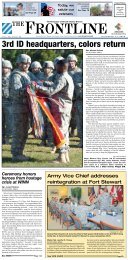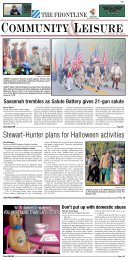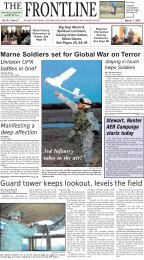News - Fort Stewart Frontline Online
News - Fort Stewart Frontline Online
News - Fort Stewart Frontline Online
Create successful ePaper yourself
Turn your PDF publications into a flip-book with our unique Google optimized e-Paper software.
8A The<strong>Frontline</strong> September 20, 2007<br />
3rd Infantry Division<br />
4th BCT Soldiers practice their night vision<br />
Pfc. Amanda McBride<br />
4th BCT Public Affairs<br />
You’re preparing for your mission and<br />
you know that without these you won’t be<br />
able to see. You stare out of your humvee<br />
and everything around you is green.<br />
Though it’s green, you’re able to see everything<br />
in the dark environment - even<br />
though it is nighttime.<br />
Soldiers throughout the Army go on<br />
countless missions every day and night<br />
while deployed and night vision goggles<br />
give Soldiers the ability to see and perform<br />
their duties at night.<br />
Soldiers from the 4th Brigade Combat<br />
Team participated in night driving training<br />
Sept. 14 in preparation for the brigade’s<br />
upcoming deployment.<br />
Though Soldiers are required to take part<br />
in the training, the main objective is to get<br />
the Soldier familiarized with the different<br />
NVGs and how to use them.<br />
“The purpose of this training is to familiarize<br />
Soldiers with the PVS 7 and the PVS<br />
14, said Sgt. 1st Class Charles Purnell, master<br />
driver. “It allows them to know the capabilities<br />
and limitations of these devices. It<br />
also allows them to get used to depth perception<br />
and the safety requirements they<br />
need to put in place while driving at night.”<br />
Throughout the entire training exercise,<br />
safety was always required and it was<br />
always the top priority no matter what.<br />
“The safety aspects that are used when<br />
Soldiers are doing this training is that we<br />
will not go above 15 miles per hour,” Purnell<br />
said. “The TC (track/vehicle commander)<br />
will have NVGs on to ensure that the Soldier<br />
isn’t going too far to the left or to far to the<br />
right.”<br />
Before Soldiers are allowed to drive the<br />
Sgt. Ben Brody<br />
Aboard a Chinook, Soldiers from Company B, 3rd Battalion, 509th Parachute Infantry Regiment, and<br />
Rocky, a military working dog, wait for the order to launch an air assault in the Tigris River Valley,<br />
Sept. 15.<br />
humvees with the NVGs on, they must first<br />
take a class on the NVGs to get familiarized<br />
with how they work and how to properly<br />
use them.<br />
“Another aspect is that the Soldiers get a<br />
block of instruction first so they are familiarized<br />
with the piece of equipment,”<br />
Purnell said.<br />
“We also do a daytime dry run over the<br />
route we will be taking so the Soldiers are<br />
familiar with the course prior to doing it<br />
with the NVGs at night.”<br />
Another important aspect covered in the<br />
training was for Soldiers to identify intersections<br />
and other obstructions in the road.<br />
“The purpose of Soldiers identifying road<br />
intersections to the left and the right is it<br />
allows them to know that they are using<br />
proper scanning techniques to identify<br />
road intersections,” Purnell explained. “Not<br />
just road intersections; it could be obstruc-<br />
During the operation, four Apache<br />
attack helicopters circled overhead, firing<br />
hundreds of 30mm cannon rounds<br />
at the insurgent positions.<br />
Over the past month, Soldiers from<br />
Company B, 3rd Battalion, 509th<br />
Parachute Infantry Regiment, 4th<br />
Brigade Combat Team, 25th Infantry<br />
Divison, teamed up with aviators from<br />
3rd Combat Aviation Brigade, 3rd<br />
Infantry Division, and conducted seven<br />
air assaults in the Tigris River Valley.<br />
Operation Marne Husky disrupted<br />
insurgents who fled the towns of<br />
Salman Pak and Arab Jabour in front of<br />
earlier U.S. offensives, said Lt. Col.<br />
Robert Wilson, 3rd CAB’s executive officer.<br />
“We were able to use our combinedarms<br />
capability to insert forces into<br />
areas that the enemy previously<br />
tions in the road; it could be puddles of<br />
water; it could be different things that can<br />
be seen through the NVGs.”<br />
Although the Soldiers did a dry run of the<br />
route they would be taking in the daytime<br />
prior to the night training, some Soldiers<br />
still were apprehensive about driving with<br />
the NVGs on.<br />
After given the opportunity to drive with<br />
the NVGs on, many left with a confidence in<br />
their driving, some got over their initial<br />
fear, and others learned valuable information.<br />
“I was uncomfortable at first because I<br />
thought it was going to be harder to see my<br />
surrounding areas,” said Pvt. Brandy<br />
Swackhammer, assigned to Headquarters,<br />
Headquarters Company, 4th BCT. “I feel<br />
comfortable driving now in NVGs and I<br />
think that having us help each other was<br />
beneficial.”<br />
CLINIC From Page 1A<br />
With the new school year coming soon, school-aged children<br />
were given supplies such as pens, pencils, paper and book<br />
bags.<br />
"We want the Iraqi people to know that we care and that we<br />
are doing as much as we can for them. We haven't forgotten<br />
about them," said Maj. Catherine Haverty, 3rd Civil Affairs<br />
Battalion, Detachment 1.<br />
The event was an initial step in a larger project that could<br />
bring more permanent medical care to the region.<br />
"We're hoping to turn this into a local clinic," said Capt.<br />
Daniel Joyce, 1/40th Cav. battalion surgeon. "We are working<br />
on a CERP (commander's emergency response program) project<br />
to get power and water here.”<br />
Most importantly, the region needs doctors. Currently, four<br />
local Iraqi doctors and a female obstetrics/gynecology doctor<br />
have been identified as possible candidates to work at the pro-<br />
HUSKY From Page 1A<br />
“The WTB at Winn continues to transition<br />
into a place of refuge and healing for that<br />
generation of Soldiers as the 55-member<br />
staff cadre is hired and the “working parts of<br />
the battalion gel,” said Lt. Col. Leonard<br />
Porter, the Warrior Transition Battalion<br />
commander.<br />
Staff members include doctors, nurses,<br />
social workers, physical therapists, counselors,<br />
and others funded with GWOT dollars. Winn’s<br />
WTB services also include special garrison<br />
assets now available for transitioning Soldiers<br />
and their Families.<br />
“The garrison understands that the WTB is a<br />
number one priority at <strong>Fort</strong> <strong>Stewart</strong>,” said<br />
Collins. “Col. (Todd) Buchs (<strong>Fort</strong> <strong>Stewart</strong>-<br />
Hunter Army Airfield garrison commander)<br />
and I work together closely to run day-to-day<br />
activities.”<br />
Buchs also supports the Town Hall meetings<br />
for transitioning Soldiers and their Families<br />
where presenters, such as Veterans Affairs rep-<br />
resentatives, explain benefits. Attendees can<br />
question a forum of representatives that<br />
includes the American Red Cross, Directorate<br />
of Morale, Welfare and Recreation and other<br />
subject matter experts about medical care,<br />
financial support and other relevant issues.<br />
Caregivers at the battalion include Soldiers<br />
and civilians who at any given time support<br />
approximately 200 wounded Soldiers and<br />
their Families — Families whose worlds have<br />
been turned upside down as a result of the<br />
trauma they received in the Global War on<br />
Terror, according to Porter.<br />
“These injuries change lives,” Porter said.<br />
“Soldiers are disfigured from IED exposure,<br />
gunshot wounds and others have post traumatic<br />
stress and traumatic brain injuries.<br />
Since they can no longer perform their jobs,<br />
they worry about their careers and have real<br />
fear and anxiety about their futures. ”<br />
To help minimize that stress, they’re<br />
assigned a triad of caregivers that consist of a<br />
Nancy Gould<br />
Sgt. Eddie Cockel, a South Carolina National Guardsman and transitioning warrior at<br />
Winn Army Community Hospital shows off the amenities he enjoys at the two-person<br />
modular barracks he shares with another recovering Soldier. He returned from Iraq in<br />
October 2006 with an injured shoulder.<br />
posed clinic.<br />
"We are working with them right now to figure out their<br />
schedules so they can come in and work with residents to reinvigorate<br />
the health care system here," Underwood said.<br />
Working with Iraqis will put an Iraqi face on the mission and<br />
make the clinic truly an Iraqi enterprise, he added.<br />
Although Coalition Forces will continue to provide medicine<br />
for the clinic, the medicine will be purchased through a local<br />
Iraqi company, Haverty said. She expects the medicine to<br />
arrive within 10 days.<br />
"It makes you feel pretty good," Joyce said. "It shows we care<br />
enough to come out here. They are going to remember an<br />
American doctor looked at my baby and said ‘he is OK.’"<br />
Even with limited resources, Joyce, who has a background as<br />
a family doctor, Haverty, an emergency room nurse with 35<br />
years experience, and an Iraqi army medic, Sgt. Maj. Kalid Latif<br />
primary care manager (a physician); a nurse<br />
case manager and a squad leader who ensures<br />
their medical, educational and social needs<br />
are addressed and met.<br />
The team expedites appointments and services<br />
at the installation and expedites referrals<br />
to agencies made outside the gates. According<br />
to Porter, the team helps to eliminate the possibility<br />
of service fragmentation and works<br />
closely with the Veterans Administration to<br />
expedite benefits for those deemed unfit to<br />
return to active duty.<br />
Before the WTU, warrior transition care was<br />
overseen by the Medical Process and<br />
Retention Unit— the unit that had oversight of<br />
Sgt. Eddie Cockel, a South Carolina National<br />
Guardsman who returned from Iraq in<br />
October 2006 with an injured shoulder.<br />
“I received excellent care in Medical Hold (a<br />
section of the Medical Process and Retention<br />
Unit) when I returned from Iraq,” he said, “but<br />
the WTB is better because there are more caseworkers<br />
and Soldiers now that have quicker<br />
access to them than we had in the past.”<br />
Cockel is a part of the WTB because his<br />
treatment was more than six months, a prerequisite<br />
for battalion admittance. After a year<br />
at Winn, he’s nearly recovered and is waiting<br />
for a decision from the Army’s Medical<br />
Evaluation Board to his request to retire. For<br />
convenience, he spends week days and nights<br />
in a modular home, located near the hospital<br />
and complete with amenities. He travels home<br />
on the weekends.<br />
The improvement in Cockel’s shoulder has<br />
allowed him to work at the hospital but<br />
Soldiers with more severe injuries are not burdened<br />
with the responsibility of work; nor are<br />
they required to attend Soldier training or<br />
other routine activities as healthy Soldiers are.<br />
Their primary responsibility to is to recuperate<br />
and seek the treatment they need through<br />
their squad leaders and their other care givers.<br />
Squad leaders have the full-time responsibility<br />
to care for up to 12 Soldiers at one time,<br />
said Porter. Their platoon leaders expect them<br />
to know the status of each Soldier and their<br />
Family and designates them the primary liaison<br />
to the services their Soldiers need.<br />
“The triad of care if a beautiful thing,” said<br />
Larry Wooten, Winn’s Family Readiness<br />
Support Assistant. The three primary care-<br />
Miza, were able to examine several patients and view common<br />
problems in the area.<br />
"Most of the illnesses are minor," Haverty said. "Most of<br />
them are skin, bug bites, aches and pains from arthritis, and<br />
rashes."<br />
Overall, 106 men, 43 women and 153 children were examined;<br />
the youngest being a baby born less than 12-hours prior<br />
to the event.<br />
The infant, who had a bump on his chest, was examined by<br />
both Haverty and Joyce. They believed the child's diaphragm<br />
had shifted to the left, causing the bump. The injury was not<br />
serious and should disappear as the child grows older, the<br />
medical professionals agreed.<br />
Haverty said the people were generally healthy and that<br />
most problems could be solved through proper hygiene and<br />
minor medications.<br />
thought were safe havens,” Wilson said.<br />
“By disrupting and capturing insurgents<br />
in this area, we set the security<br />
conditions for Baghdad.”<br />
From Aug. 15 to Sept. 15, troops from<br />
3rd CAB and Co. B, 3/509th PIR, captured<br />
80 suspected insurgents and<br />
killed another 43. Pilots flew 420 hours<br />
during Marne Husky.<br />
The mission was unique for Multi-<br />
National Division – Center, in that the<br />
unit primarily responsible was the aviation<br />
brigade. Typically an infantry<br />
brigade or battalion would control the<br />
ground and artillery forces.<br />
“It’s a great opportunity for us,” said<br />
Wilson.<br />
“Baker Company is a well-led, very<br />
dynamic unit. Their experience in air<br />
assault operations made them a great<br />
selection to work with us.”<br />
WTU From Page 1A<br />
givers work with other service providers who<br />
are already in place.”<br />
Wooten works with ACS staff to resolve<br />
Soldier and Family issues (such as transportation);<br />
facilitating a continuum of care<br />
and services and ensuring that the needs of<br />
wounded transitioning warriors get priority<br />
over other Soldiers and Family members.<br />
Services for transitioning Soldiers are now<br />
available at ACS but by Spring 2008 two renovated<br />
National Guard units, co-located by<br />
the modular barracks, will house services,<br />
including recreational services complete<br />
with leisure equipment, for transitioning<br />
Soldiers. Later it will be replaced with a<br />
newly constructed one-stop service facility,<br />
also located at the complex, according to<br />
Donna Finny, the SFAC director.<br />
The renovated buildings, and the new<br />
facility to follow, will include information<br />
and referral services, entitlements and benefits<br />
counseling, Family services, money management<br />
assistance, emergency financial<br />
assistance, education services, employment<br />
assistance, legal assistance, substance abuse<br />
information and referrals, installation access<br />
and vehicle registration, and many other services.<br />
These Soldiers get first priority in all services<br />
out of the ACS building now, according to<br />
Finny. She will hire a separate staff to run<br />
SFAC facilities when they are completed,<br />
which she says will have a USO atmosphere.<br />
Staff will service Soldiers these facilities, or if<br />
necessary, take services to transitioning<br />
Soldiers at the hospital or their homes.<br />
A toll-free number, 877-433-6114, is also<br />
available for requests and information, along<br />
with the number of the program ombudsman,<br />
Charles McClain, which is 800-984-8523.<br />
“Our staff is leading the way with a number<br />
of best practices,” said Collins. “We’ve got Lt.<br />
Col. Porter, who was in place here before the<br />
transition. He has the advantage of knowing<br />
and utilizing an infrastructure already in place.<br />
“We’ve made progress but still have<br />
improvements to make,” said Collins. “It’s<br />
important that everyone understands that the<br />
Warrior Transition Battalion is the number<br />
one priority here. We have to be ready to care<br />
for a generation of young men and women<br />
who have sacrificed so much.”

















